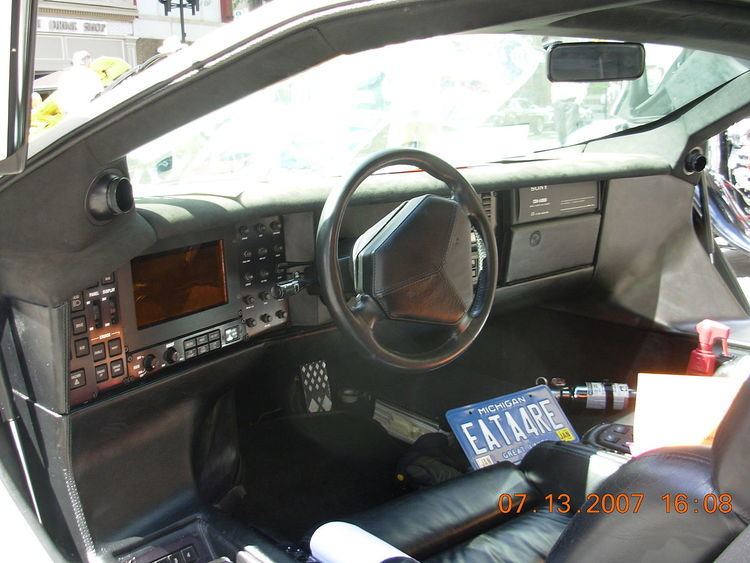Production 1989–1993 Body style 2-door coupe | Model years 1990–1992 | |
 | ||
Manufacturer | ||
The Vector W8 is an American supercar produced from 1990 to 1993. It was manufactured by Vector Aeromotive Corporation, and was designed by Gerald Wiegert and David Kostka. The company utilized the newest and most advanced aerospace materials in building the W8s, which they said justified applying to the car the term "Aeromotive Engineering." Just 19 W8s were produced (17 customer cars and two pre-production cars, the prototype W2, and the two prototypes Avtech AWX3 and AWX3R, each with a mock up of a 7.0 liter DOHC TT engine). A total of 22 automobiles were produced by Vector Aeromotive over the life of the company. The car originally sold for $448,000 new, however on today's used market, they are available from $389,000 to well over $1.4 million depending on the condition of the car.
Contents
Design
The W8 was essentially an upgrade of the same company's earlier prototype, the Vector W2. The semi-aluminum monocoque chassis was epoxy bonded and riveted with an aluminum honeycomb structure floor pan, and 5,000 aircraft specification rivets were used in the car's assembly. Everything on the Vector was designed to last the life of the owner, assuming reasonable maintenance. The body was made largely of lightweight carbon fiber and Kevlar, known for its strength, and lightness. The car was based around a Rodeck Aluminum resleevable, 365 cu. in. racing engine coupled to very highly modified Turbo Hydro 425 General Motors three-speed automatic transmissions that had been used in front wheel drive Oldsmobile Toronados dating back some two decades earlier. The engine had intercooled twin-turbos, and produced an advertised 625 bhp (466 kW) at 5700 rpm and 649 lb·ft (880 N·m) of torque on 8 lbs of boost. Boost levels were driver adjustable between 8 and 14 lbs and during dyno testing at the factory the engine put out 1200 bhp at 14 lbs of boost.
Performance and Aerodynamics
Vector claimed the W8 could reach projected top speed of 242 mph (389 km/h), with an acceleration of 0-60 mph (97 km/h) in 3.9 seconds. However, in testing at the Bonneville Salt Flats, the W-2 prototype reached 242 mph (389 km/h) with the less powerful Donovan block, as reported by Top Wheels magazine. This top speed was reached while still using the "high downforce" rear wing. Later aerodynamic testing further honed efficiency, bringing the car's drag coefficient (Cd.) down to just .32 prior to Department of Transportation crash testing in Ann Arbor, MI. The W8 design included subtle changes to the body during the production run, so that the initial car off the line looked slightly different from the last. These include the elimination of some gills, a lower front fascia and air splitter, revised rear wing, mirror intakes, and front grill. After undisclosed top speed testing was completed, production Vector W8s were no longer fitted with a removable glass roof due to buffeting that occurred at extreme speeds. Road & Track magazine published tests of the W8 in its March 1991 and August 1992 issues, and held high overall praise in nearly every aspect of the cars performance. In their own tests, the W8 recorded a 0-60 time of 4.2 seconds, and despite not conducting a top speed test, set an estimated calculation of 218MPH in coherence with its redline RPM range of the W8s 3rd gear auto transmission. Automotive journalist Douglas Kott concluded the review of the W8 with high regard for Vector and the W8; "Hats off to Gerald Wiegert and his team of dedicated engineers, and to all others with the fortitude and determination to have their dreams see the light of day."
Successor
Vector intended to follow the W8 with the AWX-3 and AWX-3R. These designations stood for Avtech Wiegert Experimental, 3rd generation, the R standing for Roadster. Unfortunately series production never got off the ground. Production of the W8 ended in 1993, when the company was subject to a hostile takeover by Megatech, but Wiegert won back the design copyrights, equipment, and remaining unsold cars. In 1995, following the hostile takeover, the new parent company Megatech LTD began production of their first car, the M12.
Media
A red 1990 W8 appears in episode 15 of the 1990 American television series The Flash.
A red 1991 W8 (chassis n003) can be seen driving across an empty lot in the early scenes of the 1993 movie Rising Sun. The car is also briefly used during a car chase at night, in which it easily outruns the police cars in pursuit, but then crashes and explodes. The car is then shown again following the crash.
A silver W8 is driven by Rutledge Wood in episode 50 of the American television series, Top Gear USA. The car was used to describe the beginning of American supercars and how it gave the Europeans a run for their money.
The Vector W8 appears in the video game Gran Turismo 2.
